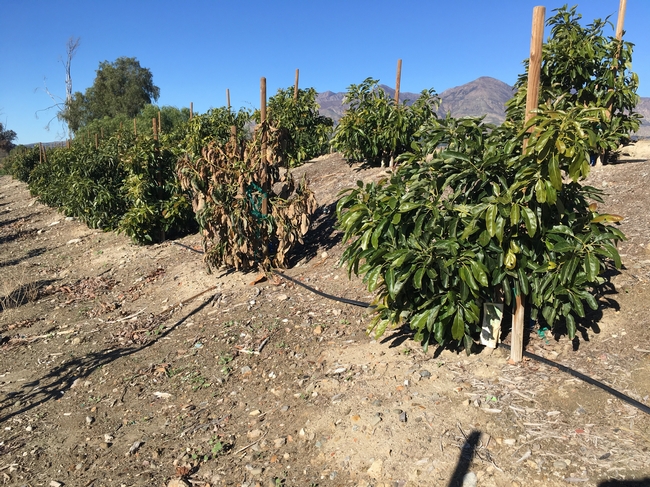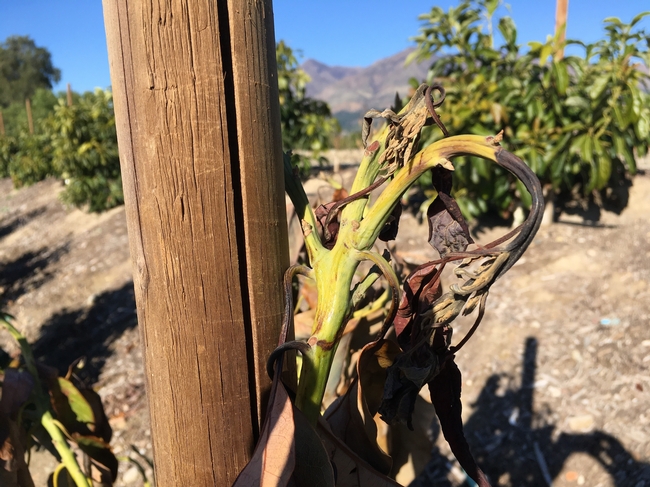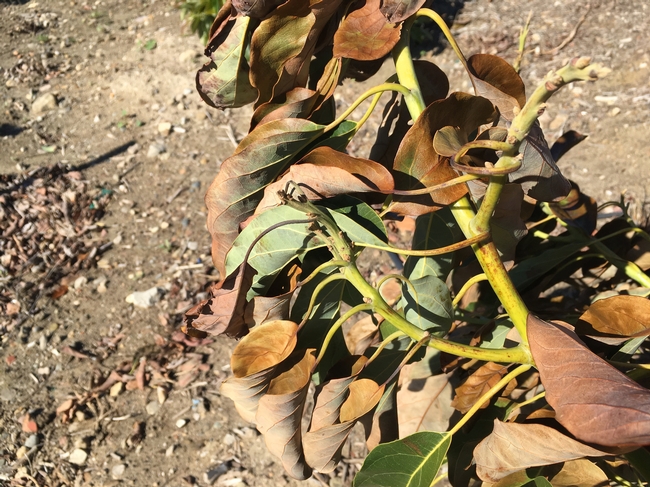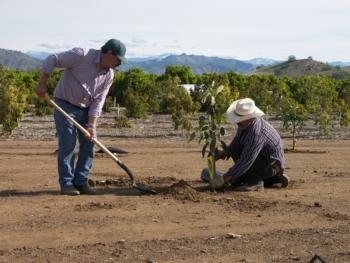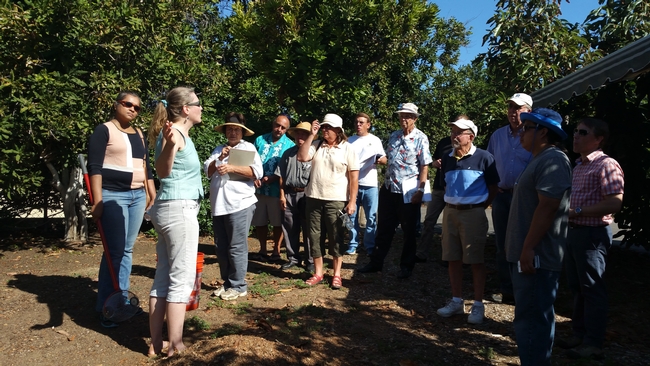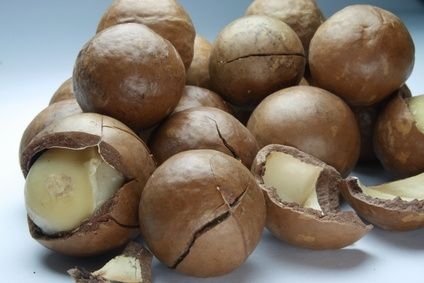
Posts Tagged: subtropical
New Topics in Subtropics Newsletter
There's a new edition of our Newsletter,
edited by Monique Rivera,
UC Subtropical Crops Entomologist -
Topics
- A “boring” problem that's generating a big interest in southern California
- How ants can be “good” in ag production systems
- Is Eucalyptus a Safe Material for Mulching Trees?
- Botryosphaeria Gummosis and Dieback of Citrus
- The online Lucid Key, Thrips of California, has been updated
Read On: http://ceventura.ucanr.edu/newsletters/Topics_in_Subtropics80946.pdf

ACP nymph wax
Why O Why, One Tree???
It's winter time and avocados and other subtropicals are prone to frost damage. Little trees especially that haven't developed a canopy that can trap heat are the most prone. So it gets cold and all the orchard looks fine, but there's one tree that doesn't look right and in a couple of days it really stands out.
Here's an example of a year old tree that turned brown and it actually looks like it was doing better than the trees surrounding. It's bigger and has a fuller canopy..... or at least it did.
But there's all the symptoms of frost damage - bronzed leaves and dead tips.
A week after the cold weather, there is already sunburn damage on the exposed stems. See the brown spots on the upper fork? That will soon turn all brown and dry up.
This is still a healthy tree with green stems, in spite of the burned leaves. Now is the time to protect the tree from sunburn damage. This is what can kill the little tree. Time to white wash it.
Why did it happen to this one tree? Maybe it was a little bigger and needed more water than the surrounding trees. Maybe sitting on a rock and didn't have enough rooting volume for water. Maybe a touch of root rot (although the roots looked pretty good even for winter time). And there were ground squirrels in the area. Easy to bklamne them.
Listen to the sound of winter frost control
https://www.youtube.com/watch?v=rwTJveN8cIE
And when freeze damage gets extreme
https://ucanr.edu/blogs/blogcore/postdetail.cfm?postnum=16448
Central Valley Avocado Meeting
Interested in San Joaquin Valley Avocados?
When: NOVEMBER 28, Tuesday, 1PM
Where:
UC Lindcove Research and Extension Center Conference Room (22963 Carson Ave, Exeter, CA 93221), Central Valley.
Tentative Program:
Welcome and Introductions – Mary Lu Arpaia, UC Riverside
Challenges to growing avocados in the Valley
Irrigation, Fertilization and Soil Requirements – Ben Faber, UCCE, Ventura County
Avocado Root Rot and how to manage – Greg Douhan, UCCE, Tulare County
What is the California Avocado Commission and the Hass Avocado Board? – Tim Spann, California Avocado Commission, Irvine, CA
Results from the Tier 3 varietal evaluation block at UC Lindcove REC – Mary Lu Arpaia and Eric Focht, UC Riverside
Ideas for the Valley Avocado Industry – Group Discussion
Walkthrough of the Tier 3 varietal evaluation block
RSVP to Diana Nix (dlnix@ucanr.edu)
For more information contact Mary Lu Arpaia (mlarpaia@ucanr.edu)

avocado cluster
Oriental Fruit Fly Quarantine in LA County
SACRAMENTO — A portion of Los Angeles County has been placed under quarantine for the Oriental fruit fly following the detection of nine flies in the Hollywood area. The quarantine zone measures 75 square miles. A link to the quarantine map may be found here:https://www.cdfa.ca.gov/plant/off/regulation.html
“California's fruit fly season extends from late summer through the fall,” said California Agriculture Secretary Karen Ross. “These pests like Southern California for some of the same reasons other travelers do: the pleasant climate and the tremendous variety of food. Fortunately, with the help of local residents, we have a great track record of eradicating these infestations.”
To prevent the spread of fruit flies through homegrown fruits and vegetables, residents living in the fruit fly quarantine area are urged to not move any fruits or vegetables from their property. Produce may be consumed or processed (i.e. juiced, frozen, cooked, or ground in the garbage disposal) at the property where it was picked.
The most common pathway for these pests to enter the state is by “hitchhiking” in fruits and vegetables brought back illegally by travelers as they return from infested regions around the world or from packages sent to California. To help prevent infestations statewide, officials asks residents to refrain from bringing or mailing fresh fruit, vegetables, plants, and soil into California unless agricultural inspectors have cleared the shipment beforehand.
While fruit flies and other invasive species threaten California's crops, the vast majority of them are detected in urban and suburban areas.
“That's why it's important for residents to cooperate with quarantine restrictions and allow authorized agricultural workers access to properties to inspect fruit and oriental fruit fly traps for signs of an infestation,” said Secretary Ross.
Following the principles of Integrated Pest Management (IPM), the California Department of Food and Agriculture (CDFA) uses a “male attractant” technique in its eradication effort for this pest. This approach, which has successfully eliminated dozens of fruit fly infestations in California, significantly reduces the amount of insecticide required to eradicate the population, and only targets the fruit flies – no other insects or animals are harmed. The treatment program is being carried out over several square miles surrounding the sites where the oriental fruit flies were trapped.
The oriental fruit fly is known to target more than 230 different fruits, vegetables, and plants. Damage occurs when the female fruit fly lays her eggs inside the fruit. The eggs hatch into maggots and tunnel through the flesh of the fruit, making it unfit for consumption.
The oriental fruit fly is widespread throughout much of the mainland of Southern Asia and neighboring islands including Sri Lanka and Taiwan, and has invaded other areas, most notably Africa and Hawaii.
Residents with questions about the quarantine may call the CDFA Pest Hotline at 1-800-491-1899.
—California Department of Food and Agriculture
Photos: OFF adults and Grapefruit infested with larvae of oriental fruit fly, Dacus dorsalis.

oriental fruit fly image

oreintal fruit fly citrus
California Macadamia Society Annual Field Day - Saturday, September 30, 2017
The University of California Cooperative Extension in conjunction with the California Macadamia Society and the Gold Crown Macadamia Association will hold their Annual Field Day on Saturday 30 September 2017, 8:45 A.M. to 1:30 P.M. at the home of Thomas & Bobbi Rastle's, 1115 Valencia Drive, Escondido, California.
We will have classes on topics germane to the macadamia industry, with plenty of opportunities for you to ask questions, both general in nature and about the specifics of your operations. We will also be serving a continental breakfast and a delicious lunch. Please plan to join us for a fun and information filled day.
Directions:
From I-5 & I-15, Exit on 78 east, Right on Broadway in Escondido, Left on Washington Ave, Right on Ash Street (it will become San Pasqual Valley Road), Right on Summit Drive, Right on Valencia Drive to 1115.
From I-15 north, Exit Via Rancho Parkway east (it becomes Bear Valley Parkway), Right on San Pasqual Valley Road, (Note: it is about four miles to San Pasqual Valley Road – Do Not Take San Pasqual Road), Right on Summit Drive, Right on Valencia Drive to 1115.
Cost: $20.00 per person if you pre-pay by 10 September 2017, $25.00 per person after that.
Visit www.macnuts.org/fieldday.htm for a registration form. Mail registration form along with your check to:
California Macadamia Society, P. O. Box 1298, Fallbrook, CA 92088
Questions? (760) 728-8081/Cell 760-580-5516 or RussellFarms@Roadrunner.com
Visit http://www.macnuts.org/fieldday.htm.


